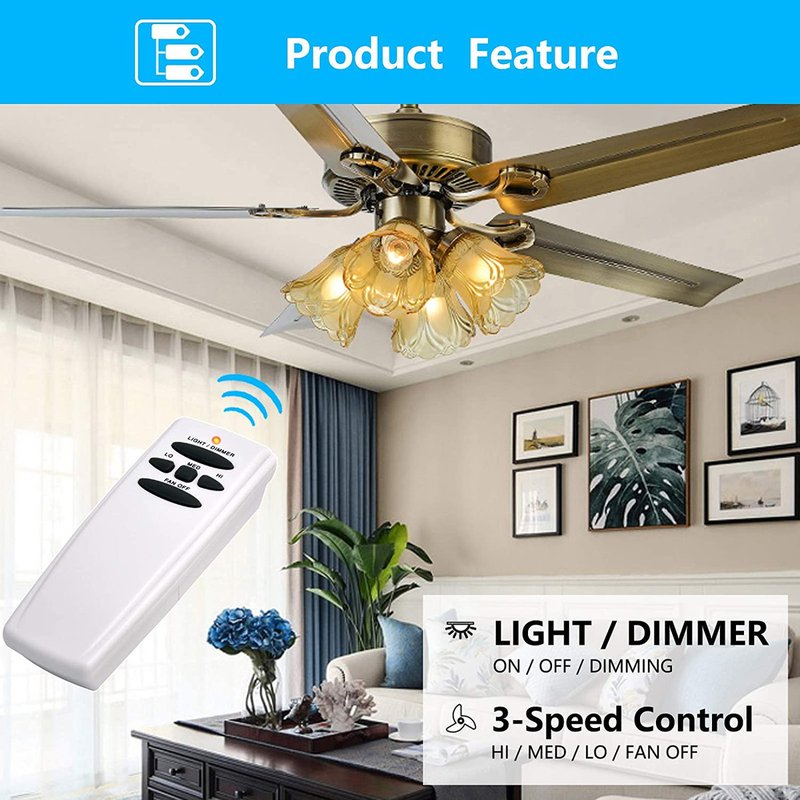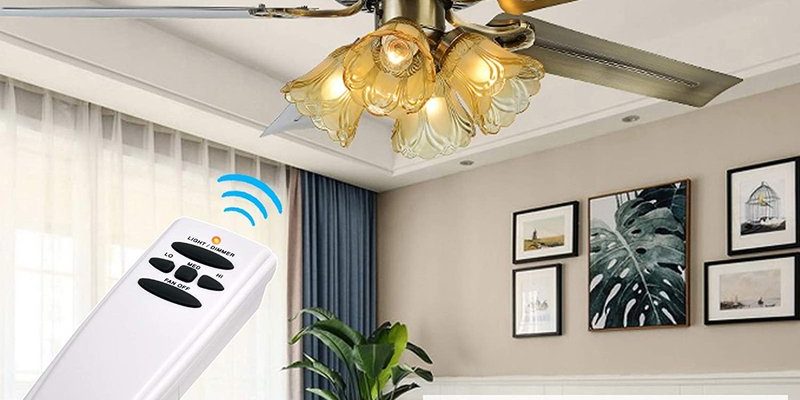
Here’s the thing: technology marches forward, but sometimes it forgets to bring all its friends along. LED bulbs are fantastic for saving energy and lasting way longer, but they’re a bit more complicated under the surface than the old bulbs. Pairing them with a fan remote—that was probably designed back when LEDs were barely a twinkle in an engineer’s eye—can be, well, a little quirky. Grab your coffee, and let’s untangle how Hampton Bay ceiling fan remotes and LED bulbs get along (or don’t).
How Hampton Bay Ceiling Fan Remotes Control Lights
To really understand if your Hampton Bay ceiling fan remote can control LED bulbs, you first need to know how these remotes work. The remote sends a signal to a receiver tucked inside the fan. Think of it like a tiny mailman, delivering your “turn the light on” command. The receiver then tells the light fixture to power on, off, or maybe dim. Most Hampton Bay remotes connect using either **infrared (IR) signals** or **radio frequency (RF) codes**.
Here’s where the magic happens—or sometimes doesn’t. The receiver doesn’t care what *type* of bulb is in the fixture. It’s just turning electricity on or off, or lowering the voltage if you’re dimming. This means, in theory, you can use any bulb you’d like, as long as it matches the wattage and socket type the fixture is rated for. But there’s a catch with LEDs, which I’ll explain in a moment.
If your remote is the original one that came with your Hampton Bay ceiling fan, you don’t need to sync, pair, or reset it—unless there’s a problem. Universal remotes may need extra steps like entering a code to match your receiver. And every now and then, a dead battery throws everything out of whack, so always check that first if your remote stops responding.
Why LED Bulbs Don’t Always Behave With Remotes
Here’s where things get a bit technical, but I’ll keep it simple. **LED bulbs** work differently from traditional bulbs. Incandescent bulbs are happy with whatever electricity you throw at them—they just glow brighter or dimmer. LEDs, on the other hand, have *drivers* (tiny circuits) inside. These drivers are picky; they expect smooth, steady electricity.
When a Hampton Bay fan remote dims or switches bulbs, it doesn’t always provide the kind of clean, consistent signal that LED drivers expect. The result? Sometimes LED bulbs flicker, buzz, don’t dim properly, or won’t turn on at all. It’s not that the remote doesn’t *see* the LED bulb—it’s that the way it talks to it isn’t always in a language that the LED “gets.”
If you use **dimmable LED bulbs** and a compatible dimmer circuit, the odds of everything working together go up, but nothing’s guaranteed unless the fan remote and receiver were specifically designed to support LED bulbs. Honestly, this mismatch is the single biggest headache for folks trying to modernize their old ceiling fans.
Choosing the Right LED Bulbs for Hampton Bay Fans
You might be wondering, “Is there a special kind of LED bulb I need?” The answer: *Sort of.* Not all LED bulbs are created equal, especially when it comes to dimming or working with ceiling fan remotes.
- Dimmable LED bulbs: Always look for bulbs marked as dimmable if your ceiling fan remote has a dimming function. Non-dimmable bulbs will either stay at full brightness or may behave strangely.
- Check wattage: Your Hampton Bay fan’s light kit will have a maximum wattage rating (often listed near the socket or in the manual). Stay under this limit.
- Bulb shape and base: Make sure the LED fits your light fixture. Most Hampton Bay fans use standard E26 bases but check just in case.
Here’s a quick table to help you check compatibility:
| Bulb Feature | Works with Remote? | Notes |
| Non-dimmable LED | Usually (On/Off Only) | May flicker or not dim |
| Dimmable LED | Yes, if remote supports dimming | Best for smooth performance |
| Incandescent/CFL | Yes | Works as designed |
Let me explain: If your old bulbs worked fine on a dimmer, switching to dimmable LEDs will probably be smooth. But if you try to dim a non-dimmable LED with your remote, you’re asking for trouble (and possibly a disco-light effect).
Common Problems With LED Bulbs and Hampton Bay Remotes
Switching to LED bulbs isn’t always a smooth ride. Here’s what a lot of folks experience right after making the swap—and what actually causes it.
- Flickering or flashing bulbs: Usually happens when the remote tries to dim a non-dimmable LED. The LED driver can’t handle the fluctuating voltage.
- Buzzing or humming sounds: That annoying noise isn’t just in your head. Some LEDs produce a faint hum when connected to older dimmer circuits.
- Bulbs won’t turn off completely: Sometimes, LEDs stay faintly lit even when “off.” This is usually caused by a small amount of current leaking through the fan’s remote receiver.
- No dimming at all: If the dimming function just doesn’t work, your remote receiver probably isn’t compatible with LEDs, or you’re using non-dimmable bulbs.
If any of this sounds familiar, don’t worry. Troubleshooting usually means double-checking bulb compatibility (dimmable vs. non-dimmable), ensuring you’re under the wattage limit, or checking if the remote receiver supports modern bulbs. Sometimes, a simple **reset** (turning the power off and on at the breaker) can clear up weird issues. Other times, only replacing the receiver with a newer, LED-compatible model will do the trick.
If your ceiling fan remote makes your lights behave like haunted house décor, the culprit is usually the receiver, not the remote or the bulb itself.
Resetting, Syncing, and Pairing the Hampton Bay Remote
So you’ve replaced your bulbs, but now the remote’s acting up. Maybe the lights won’t turn on, or the dimmer is stuck. First, don’t panic—this is super common after swapping bulbs, especially LEDs.
Here’s a basic step-by-step if you need to **reset**, sync, or pair your Hampton Bay remote:
- Reset the power: Flip the fan’s wall switch off for 10 seconds, then back on. This forces the receiver and remote to reconnect fresh.
- Check the dip switches/code: Both the remote and receiver must be on the same code. Open the battery compartment and look for tiny dip switches—match the pattern to the one in the fan housing.
- Re-pair the remote: Some newer remotes require pressing a “sync” or “learn” button (usually inside the fan base or on the receiver) while holding a button on the remote. Check your fan’s manual for specific instructions.
- Replace batteries: Low voltage from weak batteries can make remotes act haunted. Always try fresh batteries.
If you’re still having trouble, your receiver might not be compatible with newer LED bulbs or needs replacing. Honestly, these steps solve at least 90% of problems people run into after changing bulbs.
When You Need a New Receiver for LED Compatibility
Here’s a hard truth: Not every **Hampton Bay ceiling fan receiver** plays nicely with LED bulbs. Older receivers, in particular, were designed with incandescent or compact fluorescent (CFL) bulbs in mind. They handle on/off just fine, but dimming gets weird with LEDs.
If you’ve tried everything—checked bulbs, reset and paired the remote, swapped batteries—and you’re still seeing flickers or failed dimming, it might be time for an upgrade. LED-compatible receivers cost a bit more, but they’re designed to deliver smooth, consistent power just the way modern bulbs want. You don’t need to replace the whole fan, just the little receiver box tucked inside the ceiling canopy.
Most universal receivers now list *LED compatibility* right on the packaging. If you feel handy, replacing the receiver is a straightforward DIY project. Just be sure to turn off the power at the breaker and follow the instructions carefully.
Upgrading to an LED-compatible receiver is like giving your old fan a tech tune-up—suddenly, it’s ready for a whole new decade of bulbs.
Universal Remotes vs. Hampton Bay Branded Remotes
You might be tempted to grab a cheap universal remote from the store, especially if the original Hampton Bay remote is lost or broken. But will it work with your LED bulbs and fan setup? Sometimes yes, sometimes no.
- Universal remotes often require a pairing process or entering a code to sync with the fan’s receiver. The catch? Many only support basic on/off for lights and speed controls for the fan. Dimming LED bulbs can be hit or miss.
- Brand-specific Hampton Bay remotes are more likely to support all the original features—but if your receiver isn’t LED-friendly, even the “perfect” remote can’t work miracles.
- Mixing universal remotes with old receivers can introduce more compatibility issues, especially with LED dimming. If you want full functionality, matching receiver and remote types (and verifying LED support) is your safest bet.
Here’s my advice: If you just want on/off control, most universal remotes will do. But if you care about smooth dimming or having everything work with LEDs, stick with Hampton Bay-branded remotes—and double-check that your receiver matches.
What To Do If Your Hampton Bay Ceiling Fan Remote Still Won’t Work With LED Bulbs
By this point, maybe you’ve tried every trick in the book—resetting things, checking codes, even swapping in different LED bulbs. And yet, the struggle continues. Before you throw your remote in frustration, here are a few more things to consider:
- Double-check for loose wiring in the light kit. Even a slightly loose connection can cause weird behavior, especially with sensitive LEDs.
- Try a different brand of dimmable LED. Some brands just play nicer with older receivers.
- Test with an old incandescent bulb. If everything works with the old bulb, the issue is probably LED compatibility, not the fan or remote.
- Contact Hampton Bay support with your fan’s model number. Sometimes, they can recommend specific parts or settings for your exact setup.
If nothing works, replacing the receiver (and possibly the remote, if it’s outdated) is usually the fix. You don’t need to replace your whole fan—just the brains of the operation. And if you’re not comfortable with electrical work, an electrician can handle the swap in under an hour.
Wrapping Up: Hampton Bay Remotes and LED Bulbs—Friends, But With Limits
So, can a **Hampton Bay ceiling fan remote be used with LED bulbs**? The short answer: yes—for basic on/off, almost always. For dimming or fancier controls, only if you’re using dimmable LEDs *and* your remote receiver supports modern bulbs. Otherwise, you might see flickering, buzzing, or just plain weirdness.
LEDs are here to stay, and with a few careful choices—like selecting the right bulbs, checking your receiver, or possibly upgrading your gear—a Hampton Bay ceiling fan can work beautifully with them. If things get funky, remember: you’re not alone, troubleshooting is normal, and there’s always a solution (even if it’s just giving your fan a small tech upgrade). Your living room deserves great lighting and a comfy breeze, and with a bit of patience, you can have both—remote in hand.
